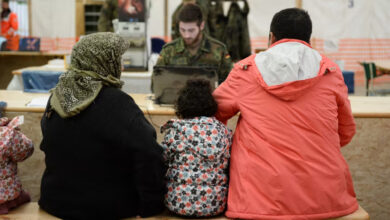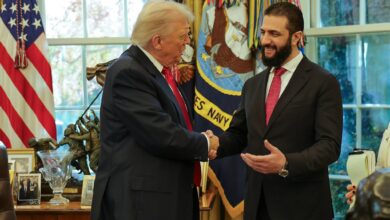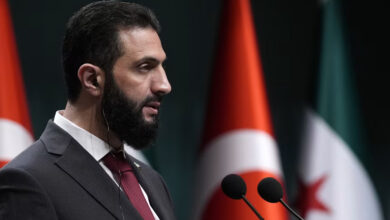Beirut — Syrian security forces opened fire Friday on thousands of protesters demanding regime change, killing more than 30 people in a sign that President Bashar al-Assad is prepared to ride out a wave of rapidly escalating international outrage.
The UN said it is sending a team into Syria to investigate and the European Union is expected to place sanctions on Syrian officials next week — both significant blows to Assad, a British-educated, self-styled reformer who has tried to bring Syria back into the global mainstream over his 11 years in power.
In Washington, State Department spokesman Mark Toner said the US was pressing the Syrian government to cease “violence against innocent citizens who are simply demonstrating and trying to state their aspirations for a more democratic future.”
Friday’s protests spanned the nation of 23 million, from the capital to the Mediterranean coast and the arid northeast. The bloodshed was the latest spasm in what has become a weekly cycle of mass protests followed by a swift and deadly crackdown.
But pressure was mounting on Assad, who insists the unrest is a foreign conspiracy carried out by “terrorist groups.” More than 580 civilians and 100 soldiers have been killed since the revolt began, rights groups say.
“What it looks like here is a systematic attack on a civilian population, a political decision to shoot to kill unarmed demonstrators and that could very well be a crime against humanity,” Human Rights Watch counsel Reed Brody told AP Television News.
Assad, who inherited power from his father in 2000, is determined to crush the revolt that has now become the gravest challenge to his family’s 40-year dynasty.
He has tried a combination of brute force, intimidation and promises of reform to crush the unrest, but his attempts have failed so far.
Still, Syria is a highly unpredictable country, in part because of its sizable minority population, the loyalty of the military and the regime’s web of allegiances to powerful forces including Lebanon’s Hizbullah and Shia powerhouse Iran.
Serious and prolonged unrest are likely to hurt the regime’s proxy in Lebanon — Hizbullah — and weaken Iran’s influence in the Arab World.
Even as protests were raging on Friday, Syria’s prime minister announced the formation of a committee to study ways to combat corruption. In the past, the overtures would have been seen as significant concessions. But protesters were largely unmoved, inspired by the uprisings sweeping the Arab World and enraged at the mounting death toll in Syria.
Now, the protesters are seeking the downfall of the regime.
Thousands of protesters took to the streets Friday despite a security chokehold on the most volatile areas along with a stepped-up intimidation campaign.
“The regime has resorted to scare tactics used by Assad’s father in the 1980s,” said Radwan Ziadeh, a visiting scholar at the Institute for Middle East Studies at George Washington University.
Assad’s father, Hafez Assad, kept Syria under rigid control for three decades. His most notorious act was crushing a Sunni uprising in 1982 by shelling the town of Hama, killing 10,000 to 25,000 people, according to Amnesty International estimates. Conflicting figures exist and the Syrian government has made no official estimate.
But for the next two decades, until his death, Hafez Assad ruled uncontested and the massacre was seared into the minds of Syrians.
Though Bashar Assad has not done anything on the scale of the Hama massacre in his 11 years in power, his crackdown has evoked memories of his father’s brutal legacy.
The tactics include a policy of “collective punishment” by arresting entire families to pressure their relatives into turning themselves in. The regime also has turned flashpoint areas into security zones, flooded with soldiers, tanks and snipers.
But Ziadeh said the mere fact that people staged protests despite all these measures shows that the regime’s strategy is backfiring.
“They may have succeeded in suppressing the protest movement for a while, but in the long run, these tactics will only backfire,” he said. “The regime is damaged and it will be very hard for it to stay in power.”
Rallies were held in major areas including the capital, Damascus, and its suburbs, Banias on the coast and Qamishli in the northeast.
A prominent human rights activist told The Associated Press that 30 people were killed Friday, all of them protesters.
The toll included 15 people in Homs, six in Hama, five in the seaside city of Latakia and one in Deir al-Zour, the activist said. He asked that his name not be published out of fear for his personal safety.
A resident of Saqba, a suburb of Damascus, said security forces shot and killed a man riding a motorcycle as he approached a checkpoint.
“They fired so many bullets, around seven…Then they took the body, put it in a van and washed away the blood on the street,” the resident said, who also requested anonymity for security reasons.
Footage posted on YouTube showed protesters in Hama frantically trying to resuscitate a man lying on the ground with a bloodied face and shirt, while people shouted “God is great!”
State-run television said an army officer and four policemen were shot dead by a “terrorist group” in Homs. It did not elaborate.
“We were chanting, peaceful, peaceful, and we didn’t even throw a stone at the security forces,” said a witness in Homs, who said some 10,000 people were in the streets. “But they waited for us to reach the main square and then they opened fire on us.”
Gunshots rang out even after the protesters dispersed, said the witness, who like other activists spoke on condition of anonymity for fear of government reprisals.
“The bullets are like rain,” he said. “Everyone is terrified.”
Syrian authorities also detained Riad Seif, a leading opposition figure and former lawmaker who has been an outspoken critic of the regime during the uprising, according to the Syrian Observatory for Human Rights.
Amnesty International said at least a dozen prominent rights and political activists in Syria have been forced into hiding after receiving direct threats of violence and arrests from authorities. They include opposition figures Haytham al-Maleh and Walid al-Bunni and the son and daughter of Kamal Labwani, who is a political prisoner.
In the Damascus suburb of Douma, scene of intense protests over recent weeks, security forces cordoned off the area to prevent anyone from entering or leaving.
A witness near Douma said he saw a train carrying about 15 army tanks heading north Thursday evening toward the central province of Homs.
Another activist in Damascus said hundreds of people marched in the central neighborhood of Midan. In Banias, witnesses said more than 5,000 people carrying olive branches and Syrian flags also were calling for regime change.
“Our morale is high, they cannot stop us no matter what they do and how many people they arrest,” he said.
In the southern city of Deraa, where the army announced the end to an 11-day military operation Thursday, residents said troops were still in the streets, causing many to stay away from a protest there on Friday.
“There’s a tank stationed at each corner in Deraa. There is no way people can hold a protest today,” a resident said by telephone. “It means more killing. Deraa is taking a break. We don’t want to see more killing or face tank guns.”




